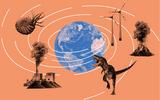MEK – K2 T1 I1 – A past sea shapes the present
The teeming life of a tropical marine paradise in the Jurassic period leaves behind massive layers of limestone – the key ingredient for carbon-intensive cement production.
Plesiosaurs and ichthyosaurs hunt for prey. Sponges and sea lilies occupy the sea floor, ammonites glide through the water. These marine creatures have shells or skeletons made of calcium carbonate. The resulting layers of sediment solidify into limestone.
Millions of years later, the fossilised seabed is elevated by tectonic movements, making the limestone accessible for human purposes: in many parts of the world, it is quarried for use in cement production.
In some places, the floor of the Jurassic sea was densely covered by the calcareous shells of ammonites – ancestors of modern-day squid: when these animals died, they sank to the bottom and their bodies were devoured by scavengers such as sea urchins and starfish.
The empty shells, gathered together by currents, were filled and covered with mud, and the millennia-long process of fossilisation began.
Excellent news for scientists and fossil lovers: millions of years later, we can admire the exquisitely prepared ammonite graveyard in all its richness and glory. It was full of life because sea creatures such as oysters or other molluscs prefer to settle on hard substrates.
→ Object in the floor display case
Over its roughly 50-million-year history, the Jurassic sea was constantly changing, inundating new areas and retreating from others. But the waters of the Jurassic period were essentially shallow and tropically warm, like those of the Bahamas today.
This tropical paradise was home to diverse animal communities – from dense sponge grounds in coastal waters to mighty predatory ichthyosaurs in the open sea.
It also harboured the unique four-flippered plesiosaur: in the popular imagination, this marine reptile did not go extinct but still lives on today in the form of the mythical Loch Ness monster.
Unsuspected relatives in the tropical world of the Jurassic period: small, furry creatures such as Morganucodon represent early forms of mammals.
Though still egg-layers, their body structure, fur and teeth show that they are ancestors of all modern mammals, from the shrew to the blue whale – including human beings.
Jurassic marine organisms used carbon dioxide CO2 and calcium to build their calcareous shells. This has an influence on today‘s world.
Limestone and marl are used to produce cement, an ingredient of concrete. When the rock is heated, the CO2 bound in calcium carbonate is released, making a massive contribution to global warming.
Sea lilies – animals despite their name – with stalks several metres long swayed in the tropical waters. Their delicate bodies were supported by an endoskeleton made of calcium carbonate.
Similar calcareous plates (ossicles) can also be seen in the magnificently preserved starfish. Over time, the remains of such marine creatures gave rise to thick layers of limestone.
→ Objet dans la vitrine de sol
For millions of years, sponges have formed magnificent marine gardens, teeming with other life forms such as sea urchins, sea lilies and starfish.
Some sponges have an endoskeleton consisting of sharp rods (spicules) made of silica or calcium carbonate. Only these types survive in fossilised form.
→ Objects in the upright display case
Evidence of a drama which played out 180 million years ago: a young marine crocodile with a broken lower jaw – perhaps a result of merciless hunting.
We can see that the injury healed – but the animal seems not to have caught any more prey. In the end, it perished, sank into the mud and was fossilised.
- A: Ancient fish, Lepidotes, with thick, robust scales, 0.5 m long, in floor showcase
- B: Marine crocodile, Pelagosaurus, with broken lower jaw, 3 m long, in wall showcase
- C: Sea urchin, similar to those found today
- D: “Ammonite graveyard”, shells of ancestors of modern-day squid, in floor showcase
- E: Morganucodon, an ancestor of modern mammals – including humans – 0.1 m long
- F: Belemnite, similar to modern squid (Kalmar). Internal skeleton up to 0.7 m long
- G: Ichthyosaur, a marine reptile , though dolphin-like, 4 m long
- H: Plesiosaur, marine reptile with paddle-like limbs (Loch Ness monster?), 20 m long
- J: Ammonite, an ancestor of modern squid, up to 1.5 m in diameter, in floor showcase
- K: Starfish, similar to those found today, in wall showcase
- L: Sponges, similar to those found today, in floor showcase
- M: Sea lily, a plant-like animal, up to 12 m tall, in wall showcase
Like all inhabitants of the Earth, we humans are inextricably bound up with the history of our home, this planet.
We have evolved, over an inconceivably long period, from a series of astonishing ancestors – in most cases, the relationship is not immediately obvious. Shown here are just a few important stages in this process.
Discover our astonishing relatives!
- Human
-
Homo sapiens
170 cm
ab 0.3 Mio. Jahre
Holozän
- Early monkey
-
Aegyptopithecus
60 cm
38-29 Mio. Jahre
spätes Eozän – frühes Oligozän
- Early primate
-
Purgatorius
20 cm
65 – 57 Mio. Jahre
Paleozän
- Early mammal with placenta
-
Eomaia
15 cm
130 – 125 Mio. Jahre
frühe Kreide
- Early mammal
-
Morganucodon
11 cm
220 – 170 Mio. Jahre
späte Trias – mittlerer Jura
- Mammal-like reptile
-
Dimetrodon
350 cm
300 – 272 Mio. Jahre
frühes Perm
- Mammal-like reptile
-
Haptodus
150 cm
310 – 285 Mio. Jahre
spätes Karbon – frühes Perm
- First animal with “spine”
-
Myllokunminigia
2.8 cm
525 – 520 Mio. Jahre
frühes Kambrium
- Early single-celled organism
-
0.0001 – 0.00001 cm
Ab 3'600 Mio. Jahre
frühes Präkambrium
